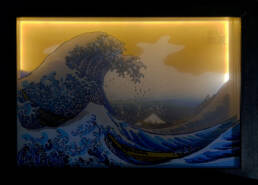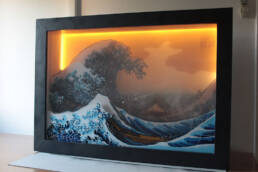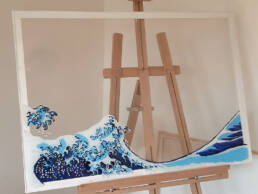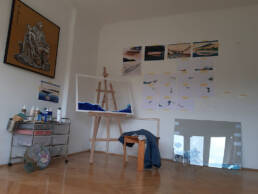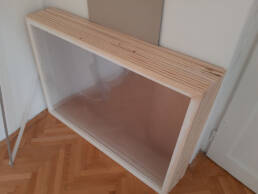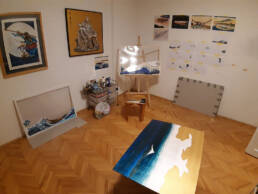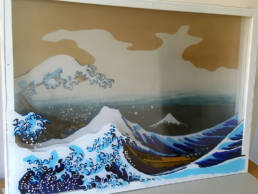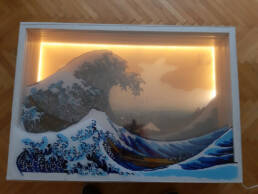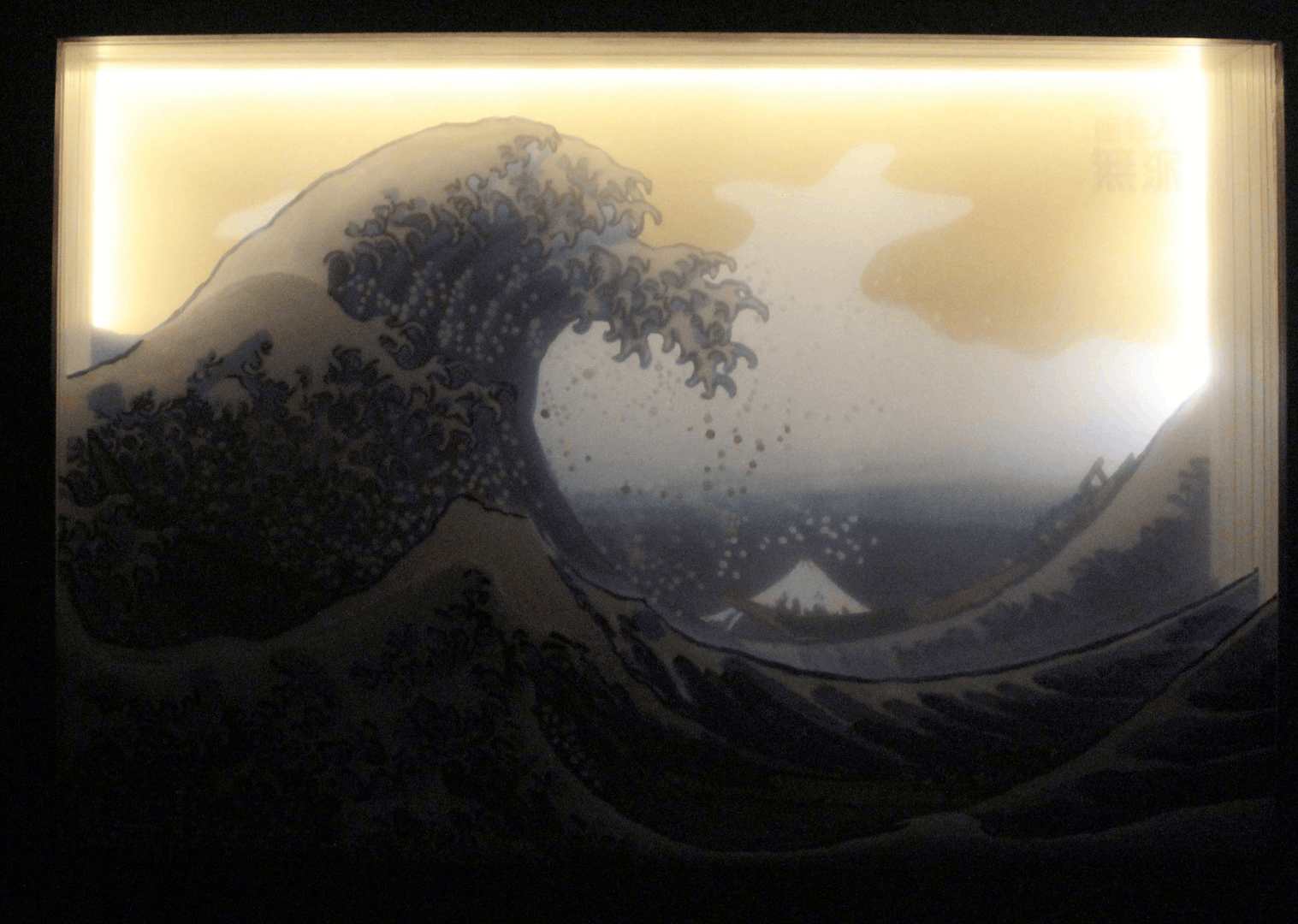The Great New Prototype Wave (V0.1)
To see this in 3D please download stereoscopic jpgs that you can use with your VR set
Or .mpo files that you can use with your VR set and 3DS
Wave 1080p 1 & Wave 1080p 1 3DS; Wave 1080p 2
Or try to feel the illusion of depth with this (round motion) 3D gif
Sometimes, subconsciously, you really want to hit that wall, hit it with all your might, and hit it again, until you break through, no matter what, stubbornly, fists clenching, blinded with your tears, sweat and blood, agonized by your thoughts to give up and do something comfortable, dance in your safe zone. I usually control this need by carefully planning- looking for the best moment to punch that wall directly into breaking point, take it down in one swing. That is what I was thinking that I was doing when I started working on this Wave. I planned everything, did 3D simulation, found companies who can provide me with well-prepared materials to build upon and I had the time, the money and the space to do it. And then the Murphy’s Law kicked in. Everything that could go wrong went wrong. And I mean everything. From incorrectly cut and scratched Plexiglas that didn´t arrive on time, scratched PVC folium, inability of stretching frame maker to understand why I need specifically designed and evenly made stretching frames… instead having all being done in 10 days, I spent 2 months working on this. I came so many times to my breaking point that I thought I would end up on antidepressants. At the end of the day I would just leave studio, come home and collapse. But I couldn´t give up. I had to end what I started.
Lately my thoughts have been occupied by Japanese diorama toys, lamps, shōji doors, basically with Japanese use of paper and light. I want to try to find a way to use some of these ideals and effects inside the painting process that goes outside of classical painting and borrows from sculpture, installation and product design. I wanted to do the Great Wave diorama with true sense of depth, ambient perspective that can be nullified by correctly placed light source. During the simulation 16 layers looked like appropriate number to have realistic sense of depth and that is how many I decided to do. In the process I realized that 16 layers are good for monumental size, for home oriented projects 8 layers would be enough. So most likely my next Wave project (Justified and Ancient Wave – All Bound for Mu Mu Land) that I have in my mind is going to be 8 layers depth (and florescent). As I said I spent lots of time readjusting material to my needs, the painting process took around 8 days; by-the-way painted surface is approximately in size of 5 of my large paintings. After painting I was experimenting in positioning, strength and type of the light source. I picked up indoor LED string of the lowest power that provided enough light that bounces between layers, lighting them from within, but at the same time having the smallest amount of light escaping outside of diorama, because my intention was not to make a lamp. To quote my wife, I created “the most beautiful fireplace”.
In these two months I learned a lot, about practical stuff like wood and plastics processing, about myself, how much I have advanced in the last 3 years, about my surrounding and how much it didn’t advance in the last 3 years (LOL), and about the Wave, how much more I will have to learn from it.
Technique: mixed media / diorama
(acrylic on plexiglass, PVC cel, canvas,
wood frame & LED lights)
Size: 76 x 106 x 25 cm
Year: June 2019
Availability: Available*
*Prices, shipping fees and payment methods are subject to negotiation.
100 Great Waves
Feb 21, 2013
In 2009 we were lucky to have Mr. Adachi from Adachi Institute of Woodcut Prints with Mr. Kyoso as a Japanese traditional woodblock print demonstrator to demonstrate and introduce this technique at the Academy of Fine Arts, Sarajevo. After demonstration I had an opportunity to show Mr. Adachi the photos of my works from 100 Views of Ukiyo-e. When he saw The Great Wave off Kanagawa, he asked me, How many copies did you do? I said, I did only one, as I was aiming to give one original painting to multicopy print. He said, No, You should do 100 copies. At first, the idea of doing 100 paintings of the Great Wave sounded impossible and ridiculous, but in time I realized, I don’t have to do it on canvas, I can do it on walls, it´s nothing new and it´s not the first time someone did it, and yet it becomes a public good unlike painting on canvas that is always private. So I´ve decided whenever I have a chance, to do the Great Wave on walls on each city that invites me to do it.
2018 – Update for the concept 100 Great Waves
As of 2018 I am no longer considering this project to be street art or public only, as this limits my experimental aspect of this series. Therefore my future works will include commissioned art works and indoor murals with private, semi-private and public access.
Diorama
This series of kacho-e (pictures of birds, flowers and insects) is inspired by Japanese cel animation and tradition of omocha-e (kumiage-e) / tatebanko. Recently I have experienced a joy of painting on plexiglass surface and this very much reminded me of transferring drawing on animation cel and coloring it. When I received a set of cels from anime in 2016, I almost had a chance to make a composition of 3 layers of cels from Arcadia of My Youth: Endless Orbit SSX, but two got stuck together, and I couldn´t separate them without damage. I wanted to experiment a little bit with PVC cel. The second source of influence comes from tatebanko (ancient setting), 2.5D paper craft diorama, that originally comes from omocha-e (paper toy for children), that could be a print of board game to diorama setting – kumiage-e, popular in late Edo period. Kumiage-e (building up pictures) is ukiyo-e print that was sold as a set for diorama of kabuki scene and they originated from paper crafted scenes for kabuki theatre and toy theatre. Tatebanko is quite popular in Japan, and the scenes can be either very easy to build (featuring characters like Hello Kitty-chan), to really complex dioramas of buildings and houses.

